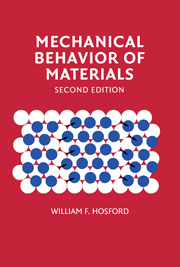Book contents
- Frontmatter
- Contents
- Preface
- 1 Stress and Strain
- 2 Elasticity
- 3 Mechanical Testing
- 4 Strain Hardening of Metals
- 5 Plasticity Theory
- 6 Strain Rate and Temperature Dependence of Flow Stress
- 7 Slip and Crystallographic Textures
- 8 Dislocation Geometry and Energy
- 9 Dislocation Mechanics
- 10 Mechanical Twinning and Martenitic Shear
- 11 Hardening Mechanisms in Metals
- 12 Discontinuous and Inhomogeneous Deformation
- 13 Ductility and Fracture
- 14 Fracture Mechanics
- 15 Viscoelasticity
- 16 Creep and Stress Rupture
- 17 Fatigue
- 18 Residual Stresses
- 19 Ceramics and Glasses
- 20 Polymers
- 21 Composites
- 22 Mechanical Working
- APPENDIX I Miller Indices
- APPENDIX II Stereographic Representation of Orientations
- Index
12 - Discontinuous and Inhomogeneous Deformation
Published online by Cambridge University Press: 05 June 2012
- Frontmatter
- Contents
- Preface
- 1 Stress and Strain
- 2 Elasticity
- 3 Mechanical Testing
- 4 Strain Hardening of Metals
- 5 Plasticity Theory
- 6 Strain Rate and Temperature Dependence of Flow Stress
- 7 Slip and Crystallographic Textures
- 8 Dislocation Geometry and Energy
- 9 Dislocation Mechanics
- 10 Mechanical Twinning and Martenitic Shear
- 11 Hardening Mechanisms in Metals
- 12 Discontinuous and Inhomogeneous Deformation
- 13 Ductility and Fracture
- 14 Fracture Mechanics
- 15 Viscoelasticity
- 16 Creep and Stress Rupture
- 17 Fatigue
- 18 Residual Stresses
- 19 Ceramics and Glasses
- 20 Polymers
- 21 Composites
- 22 Mechanical Working
- APPENDIX I Miller Indices
- APPENDIX II Stereographic Representation of Orientations
- Index
Summary
Stick-Slip Phenomena
Stick-slip phenomena involve intervals of motion separated by periods of rest. The model in Figure 12.1 illustrates the basic elements: a constantly moving driver (A), a spring (B), and a block (C) in frictional contact with a surface (D). If the static coefficient of friction between the block and the surface is greater than the coefficient of friction when the block is sliding, the motion of the block will be sporadic.
As the driver moves at a constant rate, the spring will elongate causing the force to increase. Once the force is great enough to overcome the static friction, the block will slide and will continue sliding until the spring shortens enough so that the force will drop below that needed to overcome sliding friction. At that point, the block will remain motionless until the force rises high again to overcome static friction. This is illustrated in Figure 12.2.
If plastic deformation behaves in this manner, the result is a serrated stress-strain curve. There are several possible causes of this phenomenon. One cause is dynamic strain aging, which results from the attraction of atoms in solid solution to dislocations. Because this attraction lowers the energy of the system, the solute atoms pin the dislocations. A larger force is required to break the dislocations free from the atoms pinning them than is required for them to continue moving. If the temperature is sufficiently high and the rate of deformation sufficiently slow, the solute atoms may diffuse to the new location of the dislocation and pin it again. This will result in a serrated stress–strain curve (Figure 12.3).
- Type
- Chapter
- Information
- Mechanical Behavior of Materials , pp. 199 - 207Publisher: Cambridge University PressPrint publication year: 2009



